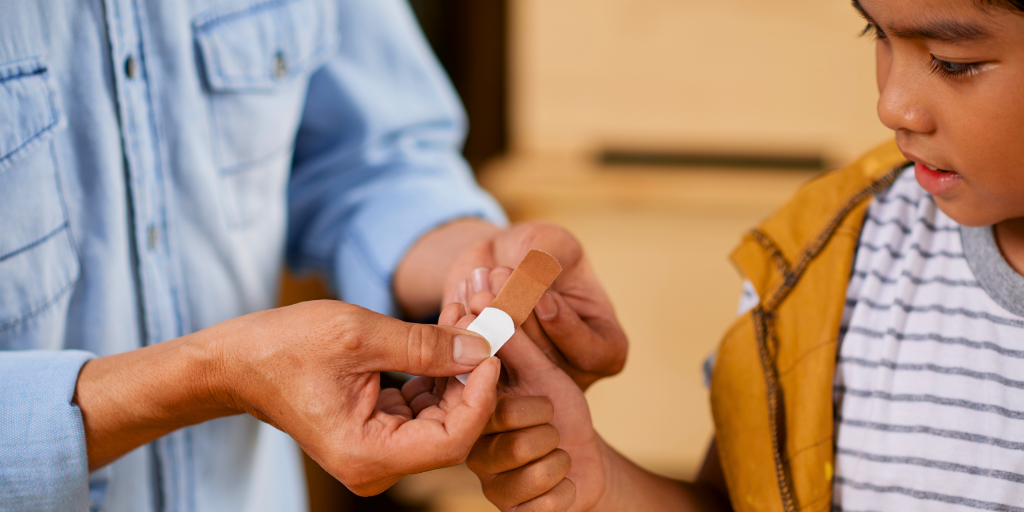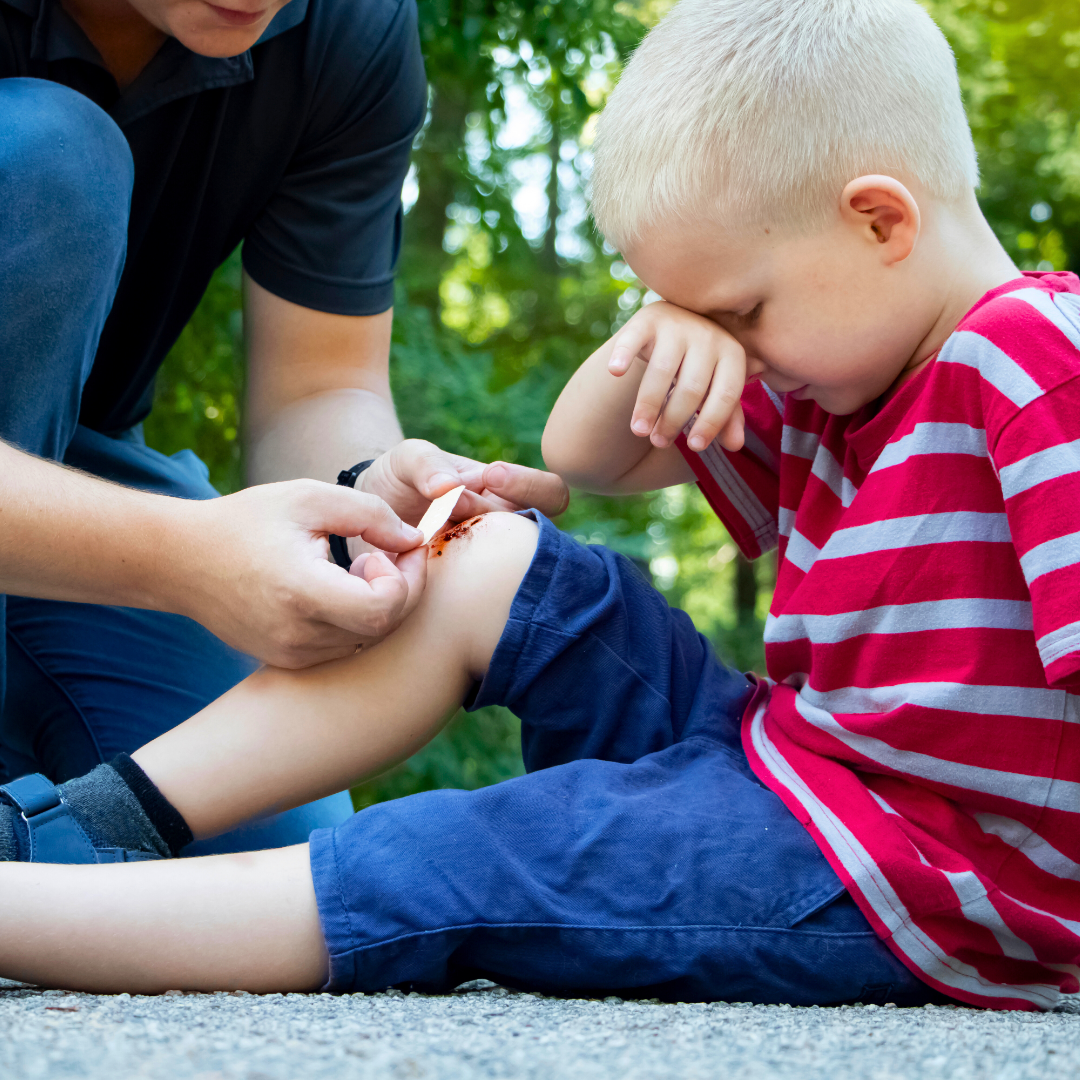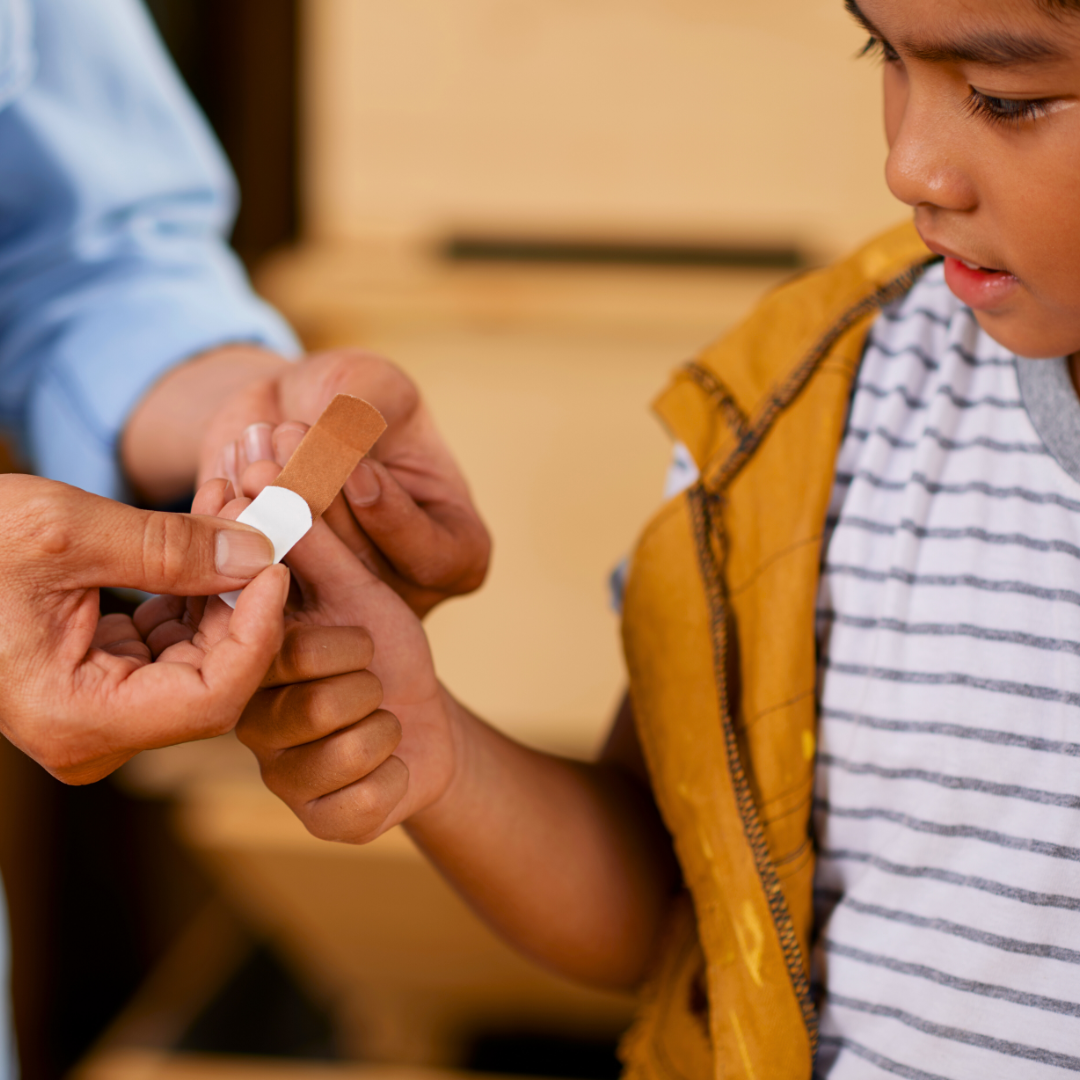
Kathryn Pasker Ineck draws an unlikely link between Band-Aids … and sacraments.
The pediatrician looked at me skeptically. “But why do you think Digit has a Band-Aid in his nose? I can’t see anything in there.”
“Because he went down for a nap with one on, and now I can’t find it.” I swayed back-and-forth in the too-small exam room, shushing Duke, and added as an afterthought, “Also, you can see that his nose is misshapen.”
Dr. Baker gave me a level look that plainly meant that he thought I was the one in need of a nap, and crouched down—for the third time—to peer into Digit’s nose. “Oh—wait! Is it green?”
“Oscar the Grouch is green. The rest of the Sesame Street characters are on there, too,” I responded, relieved that he could at least see part of it.
“It’s way up there,” he looked at Digit. “Can you blow your nose?”
I answered for my toddler: “No, he can’t blow his nose! He’s two!”
Dr. Baker handed Digit a tissue anyway. Digit took a huge, exaggerated breath and blew into the tissue with everything in his tiny body. The Band-Aid flew out. The doctor gave me a pointed look, as if to say that he had plenty of other patients in need of real doctoring and that perhaps I should have tried the obvious before I rushed my babies to his office in the middle of afternoon traffic. He wasn’t wrong. (The kernel of popcorn in his ear eight years later was a real conundrum, and one the entire emergency department staff worked hard to solve. But I digress.)
This is, of course, the advent of our foundational (Jim) Ineck Family Rule: You may not wear a Band-Aid to bed. Ever.
“But!” The kids would protest. “What if I neeeeeeeed it?”
My friend Kim has the answer, a nugget of truth handed down to her by her mother: All bleeding stops.

Obviously, the kids would be allowed to have a Band-Aid during sleep if it were necessary, but the truth is that they were usually not necessary at all. Still, Jim and I spent a lot of money on Band-Aids as the kids grew. A vast array of Band-Aids decorated with Superheroes, Disney characters, and all shapes, sizes, and colors inhabited our cabinet over the years. And they were all mostly unnecessary. So why did we use so many?
Ritual.
Band-Aids serve as a physical reminder of the attention and concern we adults take for our kids—and for the kids in our care. When a child feels pain, he or she wants to be tended to: they want assurance that they are okay. We inspect their skin, treat them, hug them, wipe away their tears … and seal all of our attention in a Band-Aid. Daisy’s friend says it simply: “It just made you feel good.”
As humans, we rely on rituals for reassurance and the physical reminders of those rituals root us to our life experiences. They offer testimony and a sense of reality to abstract things that happen to us. For a child to say, “I got hurt” is a memory: for a child to show you the Band-Aid that he or she wears as a badge of honor, it is easy to see that that badge of honor is really a badge of love. Of belonging. Of worth and of dignity.
Who knows this reality better than God Himself?
He gave us sacraments to tend to our wounds, sacraments that effect real healing with their accompanying ritual and physicality. We have Baptism to heal us of Original Sin, and we have the water and oil as physical reminders that point to a greater reality of Love. We have the Holy Eucharist to offer us food and drink, and we have His Body and Blood to physically nourish us.
Each of the seven sacraments offers a prescribed action (such as when the bishop lays his hands on the confirmandi’s head during Confirmation); prescribed words (renewal of Baptismal promises); and prescribed objects (chrism oil).
Several of the sacraments are limitless—frequent reception of them offer us touchpoints to the grace God has for us. Duke, now a seminarian, explains:
It increases sacramental grace—the tangible grace of the soul. If you have a tree that is healthy and receives water and sunlight—"regular" grace—sacramental grace is the fertilizer that improves the tree’s health. That sacramental grace—fertilizer—encourages the growth of fruit on the tree: the fruits of the Holy Spirit.
And Daisy reminds us that, “unlike Band-Aids, sacraments can be worn to bed.”

Copyright 2023 Kathryn Pasker Ineck
Images: Canva
About the Author

Kathryn Pasker Ineck
Married for more than two decades to her best friend, and mom of four teens, Kathryn finds that life is never boring. She pursues the heart of God--led by His gentle Mother--and relies on the Divine Mercy Chaplet, a desire for chocolate, and an insatiable thirst for reading into the wee hours of the morning. She writes to maintain her sanity at Kathryn Pasker Ineck.


.png?width=1806&height=731&name=CatholicMom_hcfm_logo1_pos_871c_2728c%20(002).png)
Comments